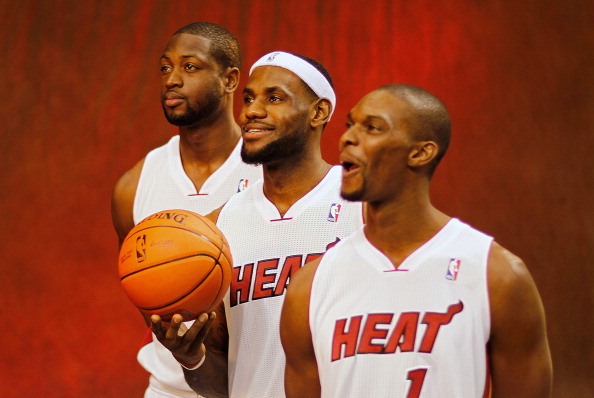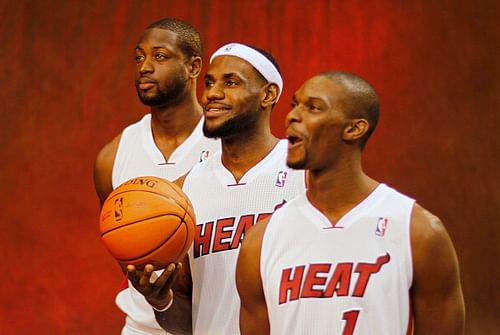
One-through-five: the Miami Heat's 'position-less' basketball

The real difference between the 2011 and 2012 NBA Finals, Erik Spoelstra would have you believe, was the Heat’s change in lineup philosophy. Spoelstra started a lineup featuring Chalmers/Wade/James/Battier/Bosh through the Finals and watched as they ran away with a series most basketball analysts didn’t see them winning. He calls this approach ‘position-less’ basketball, a catchphrase that has been around in college/pro basketball in some shape or form since the late 70s. The idea is to have as many versatile players on court who can play multiple positions on offense/defense as possible. In many ways, the Heat are uniquely positioned to exploit such a strategy – no other team could get away without playing solid big men because they would get crushed on the boards. LeBron and Wade are probably the best rebounders at their positions in the league; this keeps the Heat in the battle. LeBron, in particular, has had to do most of the heavy lifting on the boards as minutes for Anthony/Haslem fell steeply in the Finals.
Through the 2011-12 regular season, the Heat started a Chalmers/Wade/LeBron/Bosh/Anthony lineup and played Battier in clutch time. The lineup with Anthony played 534 minutes with a +/- of +105 overall, easily the most used lineup for the Heat during the regular season. In comparison, the lineup with Battier played 63 regular season minutes, going +33 in that span. The playoffs, however, was another story altogether. Spoelstra has long been criticized for over-tinkering with his lineups, but he continued to play different lineups each game deep into the postseason, mainly due to the injury absence of Chris Bosh. When Bosh was available, Spoelstra’s choice was clear. The lineup with Bosh and Battier in the frontcourt was the Heat’s most used lineup in the postseason, clocking in at 160 minutes (mostly in the Finals), with the Heat’s offense proving deadly (112 Offensive Rating) in such situations. Joel Anthony, in comparison, all but vanished when Bosh was around, forcing the Thunder to play Kendrick Perkins sparingly as well. Playing Battier allowed Spoelstra an extra offensive weapon (and Battier’s hot shooting from behind the arc was probably the game-changer for the Heat) while also allowing for versatility on defense.
To appreciate Spoelstra’s guts in playing such a ‘position-less’ lineup, one must first understand the Heat’s (and by extension, Pat Riley’s) organizational logic. It takes a small catastrophe for the Heat to change its much-famed ‘culture’ that emphasizes continuity and a back-to-the-basics approach. Pat Riley has always played traditional lineups featuring big men. Of course, he had the luxury of Kareem/Ewing/Mourning/Shaq when he coached. Spoelstra, in comparison, has had Jermaine O’Neal/Haslem/Magloire/Dampier/Big Z/Turiaf/Anthony. After playing conventional lineups in his first three seasons as coach, Spoelstra decided to go all-in with the Battier move this Finals; it worked.
With the off season additions of Ray Allen and Rashard Lewis, the Heat have signaled their commitment to the fluid, ‘position-less’ approach, marking a watershed moment in franchise history (such is the power of an NBA championship). The signings of Allen and Lewis would help any NBA team significantly, but perhaps no team more so than the Heat. Allen is unique in the same way Wade/Lebron are – he can play three positions on offense fairly well. The Heat’s rotation-heavy defense diminishes the importance of man-defense, so Allen’s height should allow him to guard multiple positions on defense as well. Both Spoelstra and Riley guaranteed Allen starter’s minutes in a substitute’s role (another change in team philosophy – the Heat never guarantee minutes before training camp). Pencil Allen in for about 30 minutes a game; some of which is going to come from Battier’s quota. The Heat will almost certainly close out games with Chalmers/Allen/Wade/LeBron/Bosh, presenting opponents with all sorts of headaches. If the lineup with Battier was efficient, this lineup will be several times more so considering the best shooter in the history of the game will be replacing Battier. Rashard Lewis, in his time with the Magic, showed his value as ‘stretch-four’, shooting at a highly efficient 40% clip from beyond the arc during the 2009-2010 season when the Magic made the Finals running an inside-out offense featuring Dwight at the pivot and four long-distance bombers (including Shard).
Lest this be too celebratory a narrative of Spoelstra’s approach, the strategy comes with a number of inbuilt problems. Firstly, the Heat’s veterans are too old to handle 82 games worth of banging in the post with true power forwards, especially Battier, who turned 34 this month. With Anthony under contract for three more seasons, expect to see conventional lineups as much as ‘position-less’ basketball during the regular season, with Spoelstra saving his veterans’ legs for the postseason. Playing without a true big man can also backfire on the Heat when presented with a skilled big man on the opposing team. The road to another championship will likely feature both Andrew Bynum and Dwight Howard, the two best big men in the league; much bigger obstacles (literally) than the likes of Noah/KG/Chandler etc. The Heat’s victory over the Thunder was also due to luck, in part. The Thunder play in a very similar style to the Heat, since their ‘versatile’ players are primarily perimeter players as well. Against a frontcourt of Gasol/Howard, this ‘position-less’ basketball might just wither away in efficiency.
Both the Utah (Al Jefferson/Millsap/Favors/Kanter) and Memphis (Marc Gasol/Z-Bo/Darrell Arthur) frontlines are good comparisons to what the Heat will likely face in the form of the Lakers; both those teams gave the Heat headaches during the past two seasons, no matter what lineup the Heat put on court. Conventional wisdom in the NBA holds that championships are won with quality big men and quality post play/defense and not on the perimeter. Then again, conventional wisdom never quite fathomed of a team with both Wade and Bron. The Heat have proved their one-through-five system works against perimeter play, but can it turn the tables on conventional NBA wisdom as well?